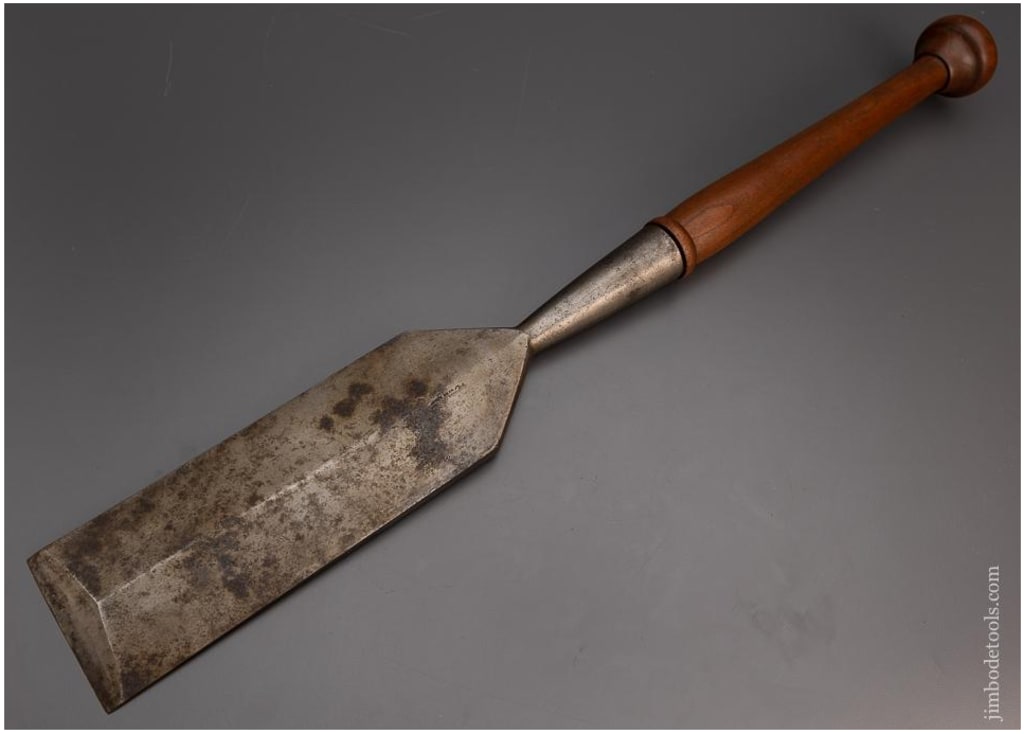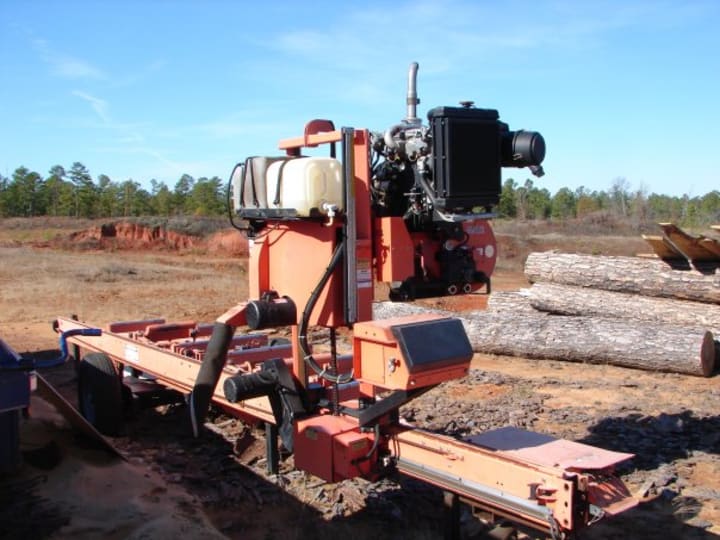
"You wanna do what?" my gorgeous bride asked me. I repeated, "I want to buy a sawmill so I can make beams so I can build us a house." She stood there looking at me like I had gone crazy. We didn't argue. We never argued. We figured out a way to help each other realize our dreams. Little did we know this dream would take us deep into the Rocky Mountains, a little town hidden away in the foothills of the Appalachian Mountains and across the Atlantic Ocean to Germany and France. My plan was to use timbers that others had discarded. Trees that had been discarded due to roads being cut or storm-damaged trees. I wanted the ability to mill these trees on my own since I would have more control over waste. I also wanted to experience the entire process of timber framing. This dream would require a significant outlay of cash but if I took care of the tools, I would be able to recoup most of that money in the reseller's market. The tools weren't cheap nor was the education. I could learn a lot from reading but there's nothing like hands-on training. I joined the International Timber Framers Guild. I bought hundreds of books. I attended seminars. I traveled.
I found a sawmill I wanted. It was a portable sawmill with hydraulics and a seat. It could be towed behind a truck to wherever the logs were stored. You could mill the logs into timbers, beams, or even lumber on-site. I bought the sawmill and a trailer. I bought other tools too like an oversized circle saw that enabled me to cut through large beams. I bought chisels and mallets and even something called a framer's chair. Along the way, I made new friends and picked up lots of advice. By the end of two years, I had accumulated everything I needed to begin milling our home except a plan. Building a timber frame home requires more than an architect. You also need an engineer, someone skilled at identifying heavy loads, and the skillset to design a home that transfers those heavy loads with pinpoint accuracy to the base of a single post atop a foundation. There is no margin for error. Fortunately, my connections in the Guild led me to the right person, Jim. He spent several months formalizing a house plan for us. He flew down to Texas to deliver it to me and to take a peek at the proposed building site. He also made a suggestion that blew my mind.

Jim suggested that I focus on filling the frame material list. Spend my time milling the timbers the plan called for. Unlike conventional building techniques, he told me not to worry about waste. If the plans called for 10 beams, mill 10 beams. He told me to let him know when I was about 75% complete and he would advertise a seminar to be held at the building site. He would benefit from the fees he collected from the attendees and I would benefit from having extra hands available to finish up the milling and help assemble the frame. All that would be expected of me would be to provide meals. We agreed and departed ways, each with our tasks to complete. At about the same time, my great aunt caught wind of my project and called me up one Friday afternoon. She told me that I might not be aware but I came from a long line of German timber framers who had immigrated from Germany to Alabama in the late 1600s. Over the years, she had collected letters and photographs from the family as part of her hobby. She had also held on to my great-great grandfather's tool chest. She invited me down to Alabama for a visit so I hoped on the next plane and by Saturday afternoon I was sitting in her parlor drinking sweet tea and nibbling on pecan pie while she showed me letters and pictures of my ancestors raising barns and building houses throughout the years. When we finished, she pointed to the attic stairs and invited me to go upstairs to the old trunk on the right. If her memory served her right, those tools were inside that trunk. I did as I was told and inside I found some old mallets, chisels, and coping saws. I also found what I later learned was a boat slick. This oversized chisel was originally used by timber framers to smooth the sides of a wooden sailing ship. The sides were made from square timbers and had to be cut down to make them all smooth like one surface. The slick is roughly three feet long and has a knob on the handle end. That knob would be held against the framer's thigh to give him enough leverage to push the razor-sharp blade through the green timber. The blade itself could be anywhere from 3-5" wide. I checked the maker's mark and it was barely legible. "DSW" and it was dated 1643. The handle was a dark red and it excellent shape. The blade was covered with an oily rag. When I removed the rag, the blade was still shiny except for a few spots of rust and it was still razor-sharp. There was also an old hand drill and some auger bits. I found an old bag and placed everything inside and brought it all downstairs for my aunt to see. She told me to take them with me, to put them to good use, and to return them when I was done with them.
By now, anyone reading this should realize a project like this is a process. It's also a labor of love.
By now, anyone reading this should realize a project like this is a process. It's also a labor of love. Yes, there are faster ways to build a home. There are more efficient ways to build a home. But I can't think of a more relaxing, more fun way to build a home that will be unique, maybe a work of art, and will last for generations to come. I left for home on Sunday with my new tools and a whole pecan pie. Come Monday morning, work began in earnest. If you've never labored on a sawmill, then it's difficult to understand how taxing it can be. When I started milling my timbers, I weighed myself at 245 lbs. Just 4 months later, when I pulled the last timber from the bed of the mill, went inside exhausted, showered, and stepped on the scale, I weighed 170lbs. It's the most exhaustive thing I've ever done and I was a U. S. Marine.
My days began before the sun rose. I had to prep the mill by making sure it was gassed up, lubricated, the belts on the diesel motor were tight, the blade was sharpened and tight and extra blades sharpened and staged nearby. I also had hand-roll logs to a staging area in front of the mill's hydraulic arms. There's a noise ordinance in our town, so I couldn't crank any heavy equipment before 7 am. Then I checked the chainsaws, and the timber staging area to make sure everything was ready to go. At 7 am, I cranked the chainsaw and "bucked" each log to the lengths I needed for my timbers. Bucking a log means I trimmed off any protruding knots and cut the log to 6" longer than what I thought I would need the timber to be. If I came across a log with a huge knot, that would be the starting point for a new timber since I didn't want large knots in my timbers. Building inspectors treat knots larger than 3" as a large hole, and that could fail an inspection later on.
Once, the logs were bucked, I jumped in the sawmill seat and turned the key. That old diesel engine would fire right up and this was when I took my first break of roughly 5 minutes. Just long enough for a couple sips of coffee. I walked over to the logs and used a pike pole to roll the first log onto the hydraulic arms of the mill. Then I jumped back in the seat and using one of 9 hydraulic levers, I lifted the log onto the mill bed, and using the other levers, I positioned and leveled the log to the best of my ability. From there, the process of squaring up a log into a timber was straightforward. I would make the first cut as light as possible taking off about an inch of wood just below the bark. This waste is called a slab and could be used for fencing or shake shingles for the roof. Then I would flip the log 90° and repeat. I would do the same for the remaining two sides and then I would size the beam into the timber or timbers I needed, with the goal of making the final timber a box-heart cut where the center of the log remained in the center of the timber. Those cuts made the strongest posts. On the smaller logs, it wasn't uncommon to get only one timber from a log, but on larger logs, it was possible to get 4 or even 5 timbers from one log. After each timber was milled, I checked them off my cut-list and carefully removed them from the mill.
This waste is called a slab and could be used for fencing or shake shingles for the roof.
Each milled timber was taken inside a large barn and stacked on runners called stickers to allow air to flow between them. This was to prevent rot and mildew from staining the wood. I used latex paint to seal the ends of the timbers to prevent them from splitting and cracking. On average, I could mill roughly 20 logs a day and produce around 50 timbers per day by myself. It was a labor of love. As I was nearing the end of my cut-list, I notified Jim and he sent the word out and within a couple of weeks, we had received confirmation that 40 people from all over the country would attend a 5-day seminar at my place. Jim arrived a couple of days earlier and inspected my timbers and helped me set up the workshop stations. The next day, the attendees started arriving. I don't want to bore you with the details, but over the next 4 days, we had the time of our lives. Jim was the consummate instructor. He would explain what needed to be done, how it was to be done, why it was done in a certain way and then he walked from station to station to make sure each and everyone was doing it the same way, correctly. If a mistake was made, he jumped in and corrected it. By the middle of the fourth day, all of the timbers had been milled and friendships had been forged for life.
On average, I could mill roughly 20 logs a day and produce around 50 timbers per day by myself. It was a labor of love.
Towards the end of the fourth day, Jim assigned each of us to a crew for the raising which was scheduled for the fifth day. He explained safety and the importance of following his lead. Some of the timbers weighed as much as 400 lbs by themselves but when assembled into a partial truss called a bent, they could exceed 3500 lbs. Jim suggested we knock off early and get a good night's rest because tomorrow would be a difficult day if we weren't prepared. The final day started earlier than the others. I think partly because we were all nervous and partly because, well, we were all nervous. I was in the kitchen having coffee when Jim walked in. He said, "I thought I smelled some of the good stuff." I handed him a cup at about the same time there was a tap on the back door. Jim opened the door and there stood ten others. It was a quarter past 4 in the morning, so we took ourselves and the coffee outside to keep from waking my family. Everyone was aware of the noise ordinance but felt like I did. As long as we didn't make a lot of noise, we could quietly preassemble the bents and stack them in the order they were to be raised. There were a total of 12 bents that needed to be raised and connected to each other.

A bent consists of two posts cut to the height of the exterior walls, two rafters atop the posts, and connected in a point forming an A-frame and some sort of truss system tying them together. The trusses are aesthetic and I had chosen a combination of king, queen, and standard trusses depending on where they located. All of the joints are pinned together with wooden pegs called treenails. We were working as quietly as we could when a police car pulled up. It was the Chief of Police. I walked over to his car and said, "Hi Mark, are we making too much noise?" He shook his head no and laughed and replied, "I was just curious if the Amish had moved to town." He got out and walked around and looked and then asked me if I was gonna need any more help raising it today. Before I could answer, Jim replied, "The more hands we have, the easier the work will go." Mark smiled and said, "Ok then, I'll be back." Soon the other attendees arrived and the sun started coming up too. Then true to his word, at about 7:30 am, Mark came back, this time in his truck and jeans and he had another 8-10 friends following him.
My wife still teases me. She tells me most men have midlife crises and go out and have an affair or buy a fast car. Not her husband. He buys a sawmill and builds a house out of a tree.
We moved the bents into position and stood them up one at a time. As each one went up, Jim supervised the placement of the girders and braces and I pegged them in place. All in all, the entire raising of the frame took about 4 hours. When it was complete, I stood back in amazement. Jim came over to me with a mallet and a 1 1/2" chisel and a 2" chisel. He told me the frame isn't quite finished until you mark it up. Jim explained that timber frames were the original mobile home. It was not unusual in bygone times for families to move. When they did, they would disassemble their homes and take them with them. In order to know how to reassemble them, they marked the joints. Jim further explained that a frame is always built from south to north with the last bent raised to the north. The post joints on the west side are marked in Roman numerals with a 2" chisel and the east side posts are marked with a 1 1/2" chisel. Each bent is numbered from one to however many bents there are. In my case, twelve. Finally, a bough taken from the original tree milled was customarily hung from the peak of the last bent raised to pay homage to the trees that went into building the frame. Aside from being an amazing engineer and instructor, Jim was also a fantastic historian. We marked the posts and hung the bough.
People exchanged contact information and bid their farewells and started to part company. One man and his son approached me and asked me what did I plan to do with the sawmill now that I had finished my frame. I told him I hadn't thought that far ahead yet but I really had no need for it anymore so I would most likely sell it. He asked me what I had paid for it along with the tools that went with the mill. When I told him I had roughly $30,000 sunk in that investment, he asked me if I would sell it to him for that price today. I was shocked but after discussing it with him, I learned there was a shortage of mills and the new ones were going for twice that. We agreed on the price and they left only to return about an hour later with a cashier's check. I helped them load everything up and they told me their plan was to build a lakehouse. I told them to call me if they needed an extra set of hands. I would be there.

Everyone left and the frame stood assembled for a few weeks to let it settle in. Then the panel framers, roofers, and carpenters arrived to finish everything out. I had accomplished everything I wanted to accomplish. My wife still teases me. She tells me most men have midlife crises and go out and have an affair or buy a fast car. Not her husband. He buys a sawmill and builds a house out of a tree.
About the Creator
Joey Lowe
Just an old disabled dude living in Northeast Texas. In my youth, I wanted to change the world. Now I just write about things. More about me is available at www.loweco.com including what I'm currently writing about or you can tweet me.






Comments
There are no comments for this story
Be the first to respond and start the conversation.